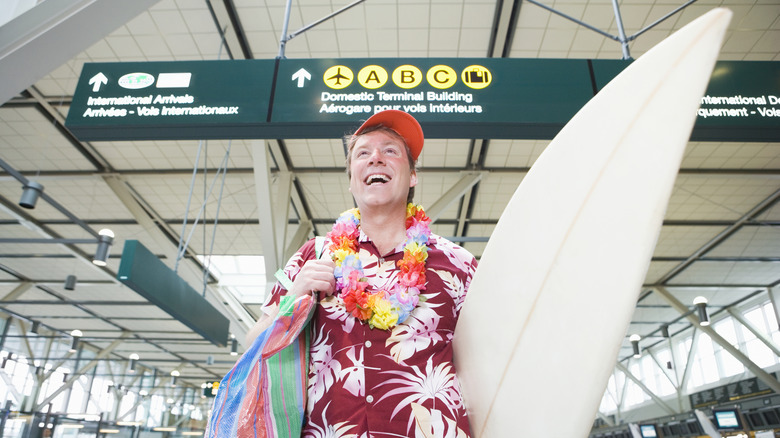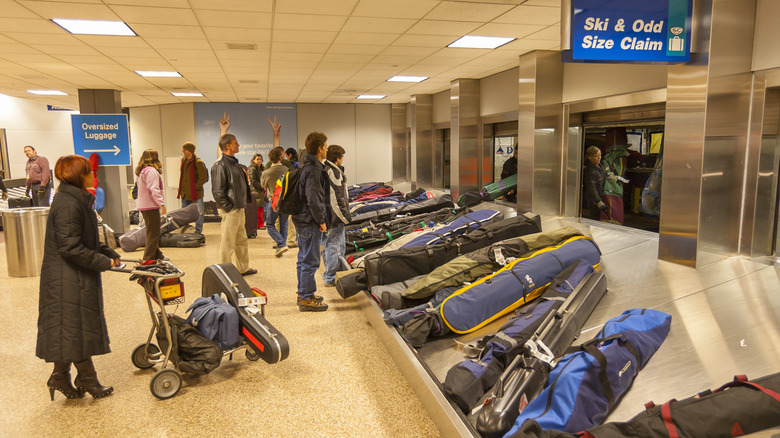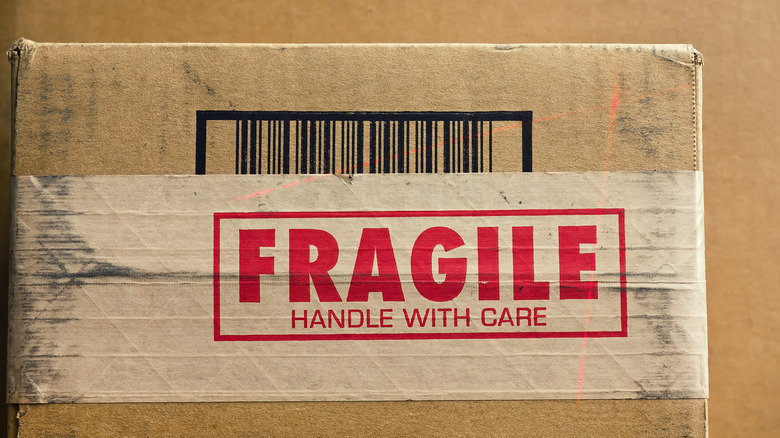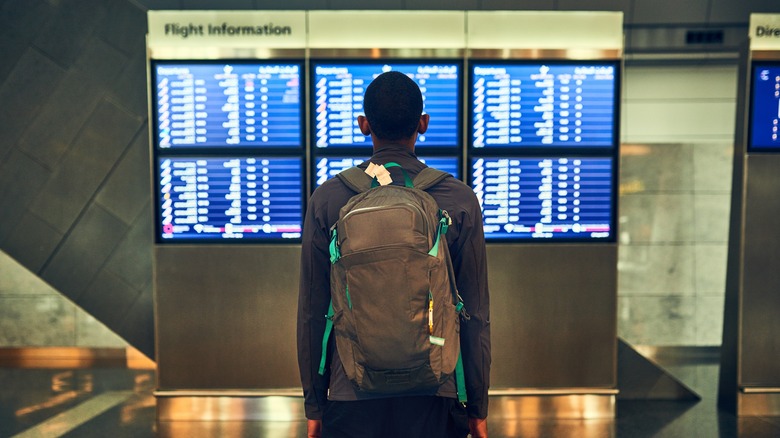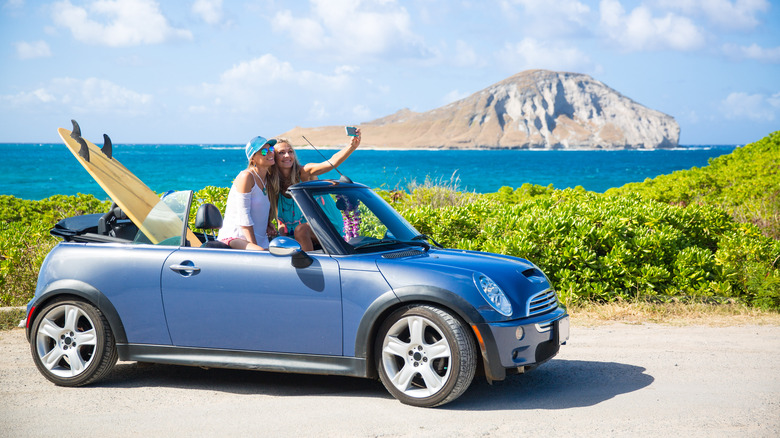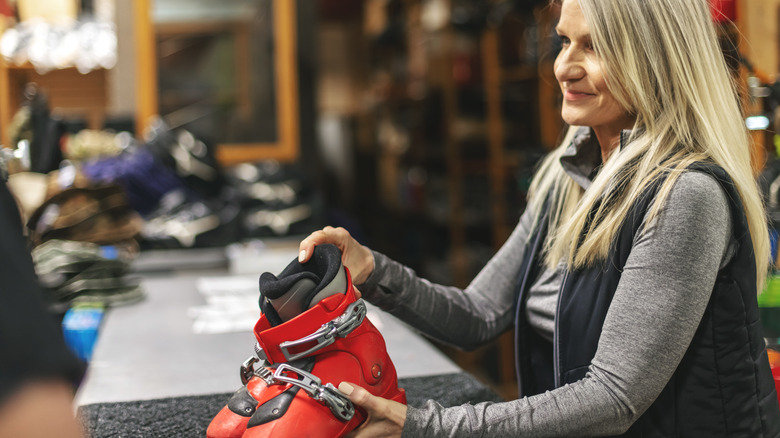9 Tips For Traveling On A Plane With Sports Equipment
Are you packing your bags for an active vacation? It's a good idea to travel with your personal sports equipment in tow. After all, riding your own bicycle can be more comfortable than renting one, hitting a golf ball with your favorite driver can help improve your score, and gliding down the mountain on a familiar set of skis can make those double black diamonds and backcountry routes more attainable. Cost, safety, comfort, and performance are all reasons to check your sports equipment into the cargo area of a flight, and doing so is a simpler process than most people realize.
That said, there are various tips you should keep in mind when traveling on a plane with sports equipment. As any adventure junkie who has previously traveled with their equipment knows, keeping this beloved, and often fragile, piece of luggage well-protected is key. It also doesn't hurt to take a few proactive steps to ensure that backup plans are in place in case your sporting equipment is delayed at baggage claim or (not to jinx it) lost. To that end, we've compiled a list of our top tips covering the many ins and outs of traveling with sports equipment. Whether you are planning to explore one of the breathtaking trails bikers should visit at least once or traveling to test your skills in a fencing competition, this guide will help novice and experienced athletes travel with greater peace of mind.
Invest in the right luggage
You can find a special bag or case for practically every piece of sports equipment, from scuba tanks and surfboards to baseball bats and javelins. During the winter, it's not uncommon to see skis being loaded onto the conveyor belt. Ski bags and boot bags come in all colors of the rainbow and feature protective padding in all the right places. Most have straps, and some have wheels to make your schlepp through the airport a bit easier. If you are on a tight budget, it can often be cheaper to decide on the bag you'd like at a brick-and-mortar shop, and then order it online (though we're all for supporting local businesses when possible).
Perhaps the most important choice of all comes with packing a bicycle. Many folks choose to avoid the added cost of a specially manufactured piece of luggage altogether, instead opting to pick up a cardboard bike box (usually for free) from their local bike shop. This option is safer than it may initially sound; remember that bicycles are typically shipped in cardboard boxes to shops, where they are assembled before being purchased by customers. Most shops are more than happy to give cyclists boxes that would otherwise be destined for the recycling bin, and especially kind employees might go out of their way to help you disassemble and pack your bike as well.
Other options for transporting your bike include bike boxes and bike bags. Both have their pros and cons; for instance, hardshell cases might offer the best level of protection, but airport staff tend not to treat them as fragile items. Additionally, different models of boxes and bags require different levels of disassembly. Know your priorities and purchase accordingly.
Familiarize yourself with airline policies
Each airline has a unique policy regarding the type and quantity of sports equipment you are allowed to check, as well as what might be allowed in hand baggage (such as tennis rackets and helmets). For example, you'll need to remove CO2 cartridges from your bicycle's saddle bag, and scuba tanks must meet several requirements, such as having an air pressure over 40 PSI.
Additionally, while airlines frequently allow travelers to include sports equipment as part of their standard baggage allowance and charge money accordingly, this is not always the case. Domestic and international policies may vary within the same airline, so make sure to read this information closely — it can usually be found on the airline's website as a subsection of the baggage information page. Unlike regular baggage, which must adhere to one universal set of dimensions, each kind of sports equipment is frequently subject to its own unique set of measurement requirements, so take note accordingly.
Of course, you should call the airline if you are unsure about any of its policies, and in fact, you'll have the perfect opportunity to get your questions answered when you call to reserve a spot on the plane for your sports equipment. That's right: Even if you don't have to pay for this kind of luggage, most airlines still ask that you make sure there is space on the plane for what can often end up being bulky, oversized baggage.
Break out the bubble wrap
Many kinds of sports equipment require special protection, such as archery bows, fishing rods, ice skates, and bicycles. While you might be able to request that a "fragile" sticker be placed on your luggage, doing so may be of little to no use; luck of the draw determines which employees will handle your baggage and how carefully they will treat it. This makes it all the more important to proactively protect your gear. If possible, keep the most fragile components of your sports equipment toward the center of your luggage, where it can be shielded by other materials. In some cases, you might be able to disassemble your equipment and carry the most sensitive components in your hand luggage.
While some airlines are more stringent than others regarding what you can pack in a checked bag for sports equipment other than the equipment itself, you might be able to use soft materials like clothing and rags for padding. Otherwise, you'll want to have items like styrofoam, bubble wrap, and packing tape on hand to keep everything safe and secure. In case the airline requires you to open and rearrange your special luggage at the check-in counter, it's not a bad idea to keep a handful of extra supplies on hand (you can throw away unused materials, if necessary).
Arrive (extra) early
What time to arrive at the airport is often a point of contention among friends and family members. Some folks like to arrive extra early, knowing that they can enjoy a bite to eat, a leisurely walk around the terminal, or a visit to an airport lounge if needed. Others prefer to cut it close and might even consider it perfect timing if they arrive at their gate while the flight is in the process of boarding. When flying with sports equipment, you need to adopt the mindset of the former category of travelers. Not only do you need time to get on the plane, but your luggage does as well.
Before you even arrive at the airport, you might face traffic jams. Then, depending on the airport, you might need extra time to lug your equipment to a special baggage drop where it can be weighed and checked. If the staff members assisting you are new or unfamiliar with your particular sports equipment, you may need to wait longer than usual for standard protocols to be executed. Of course, there is always the chance that you will need to open your luggage for inspection as well. For additional peace of mind, we recommend procuring a Known Traveler Number (KTN) for expedited security screening. After all, you typically don't need to arrive at the airport quite so early with TSA PreCheck. When traveling through an unfamiliar airport, allow extra time for navigation and, in foreign countries, immigration checkpoints.
Proactively insure your trip
Nobody likes to imagine travel plans going awry, especially when you've pored over options and logistics for hours on end. Even so, proactively insuring your trip can make it easier to adapt when life throws you curveballs. Travel insurance can help you recuperate expenses due to lost or delayed luggage, canceled or postponed flights, medical emergencies, and more. Note that airlines typically have their own policies regarding such events, some being more generous than others. For instance, if your luggage is significantly delayed, you'll likely be offered a per-day reimbursement amount to purchase necessities. However, this stipend is not always enough to make up for the costs of buying new sports equipment, which is where insurance can come into play.
You'll want to spend a fair amount of time researching travel insurance and deciding if you need it before pulling out your credit card. There are a variety of companies and plans from which to select, and your best option depends on factors like length of stay, expense of equipment, riskiness of sport, and the season in which you are traveling. Don't forget to investigate what kind of travel insurance you might already have as a benefit of your credit card. Finally, for expensive equipment that cannot be easily replaced, it's a smart idea to purchase an AirTag or similar tracking device to help airlines locate your bag in the event that it is lost. You'll be relieved to know that airlines might owe you a substantial amount when they lose your luggage.
Expect delays
When traveling with sports equipment, it's best to book direct flights whenever possible. That's because layovers, especially tight layovers, increase the likelihood of your baggage not arriving at your destination at the same time as you do. However, even if you are on a direct flight, your luggage might still be delayed. Common reasons for delayed luggage include tagging, ticketing, and loading errors; space-weight restrictions; customs delays; and luggage mishandling. That's why you should build a buffer period between the day you land and the day you wish to start using your sports equipment. If you are traveling for a competition, this period should be at least three days long, or perhaps longer if you are competing internationally.
You may or may not receive an automated text or email informing you that your luggage is delayed. Regardless, you should speak with an airline representative before exiting the airport and fill out any necessary forms. You'll then need to research where you can rent or purchase replacement products on the airline's dime. As mentioned previously, travel insurance can potentially augment this emergency fund. Be aware of the maximum amounts you will be compensated and what kinds of receipts are accepted; for instance, consumables like sports nutrition products may not be eligible for reimbursement. If all goes well, you'll soon be reunited with your sports equipment, and the delay might even work in your favor: While it may not always be the case, airlines will usually deliver delayed luggage to your doorstep, eliminating the need for you to wrestle it into a rental car or lug it behind you on public transportation.
Have plans for onward travel in place
After accomplishing the mammoth task of researching and deciding upon flight logistics, you might want nothing more than to shut down your computer and take a nice, long nap. Once you wake up, though, you shouldn't forget to research what must take place after your plane lands on the runway. This information will help cement whether or not flying with your sports equipment makes more sense than renting or shipping it.
For starters, you'll need a way to reach your accommodations. If you are renting a car, make sure that it is large enough to house your sports equipment in addition to your other luggage and, of course, yourself and anyone else who might be traveling with you. Keep in mind that you should be able to see clearly out all windows. Some cars come with overhead racks, giving you more space inside the vehicle. Although prepaying for your rental car might end up costing you money, you might want to reserve it well in advance to ensure that you don't end up with a tiny car. On the other hand, if you are traveling by public transport (for instance, by subway or train), make sure your equipment is allowed on board, and know whether it will need to be checked into a cargo area, perhaps for an additional fee.
Finally, make sure that you have a way of carrying your equipment into your hotel room or rental property. For example, if you are traveling with a bike bag and staying in a high-rise apartment or hotel, ensure that there is an elevator on site.
Ask for help
Traveling with sports equipment can be stressful and confusing, even for those who are well-versed in the endeavor. Airline policies are variable and often ambiguous, and not all airport staff are aware of the standard protocols. The challenges that one might face during a typical travel day — such as delayed flights and traffic on the way to the airport — are only amplified by the added consideration of traveling with sports equipment. That's why you should not be embarrassed to ask for help at any point along the way.
Especially if you are traveling with your sports equipment for the first time, you might need help long before you arrive at the airport. Gear shops and fellow athletes are usually more than happy to help you choose the right bags and assist you in learning how to deconstruct and reconstruct your equipment. Countless free videos are available online as well. Don't hesitate to ask for assistance at the airport, either, and come prepared with cash: You'll often need it to rent the luggage trolleys that make walking through the airport a million times easier.
If you think that you'll require more assistance and are headed to a competition, investigate whether a guided tour group is available through a service like Endurance Sports Travels. Not only do such companies help you sort out flight logistics, but they might also offer tours of your destination, organize accommodations, arrange for ground travel, and connect you to athletes from a variety of cultural and geographical backgrounds.
Know your alternatives
Even after considering the above tips, flying with your sports equipment may not always be the best decision. It's essential to be realistic about your capacity for flexibility and thinking on your feet, as it's not unusual to face roadblocks while traveling with special luggage. If you have the budget, you might look into shipping or renting your equipment instead.
When traveling for a competition or event, one potential way to save money is by coordinating with others who are traveling there as well; discounts are frequently offered by transportation services for bulk shipments. Send a message to local sports teams and gear shops to see if you can identify anyone else who might be interested in shipping their equipment. Of course, options exist for shipping your equipment solo as well. For instance, you can ship your skis to a mountain resort directly from your doorstep.
If, after researching, you decide that you would rather leave your sports equipment at home, have a plan in place for renting your equipment instead. If possible, reserve your gear well in advance; this step becomes even more critical when traveling for an event attended by other athletes, many of whom will also decide to hit up the area's rental shops. For activities that generate steady demand, however, such as skiing or mountain biking, you can generally expect to find plenty of rental equipment available. No matter what, be prepared for a potential learning curve as you adjust to the new gear; there's no telling how old it will be or in what condition.
